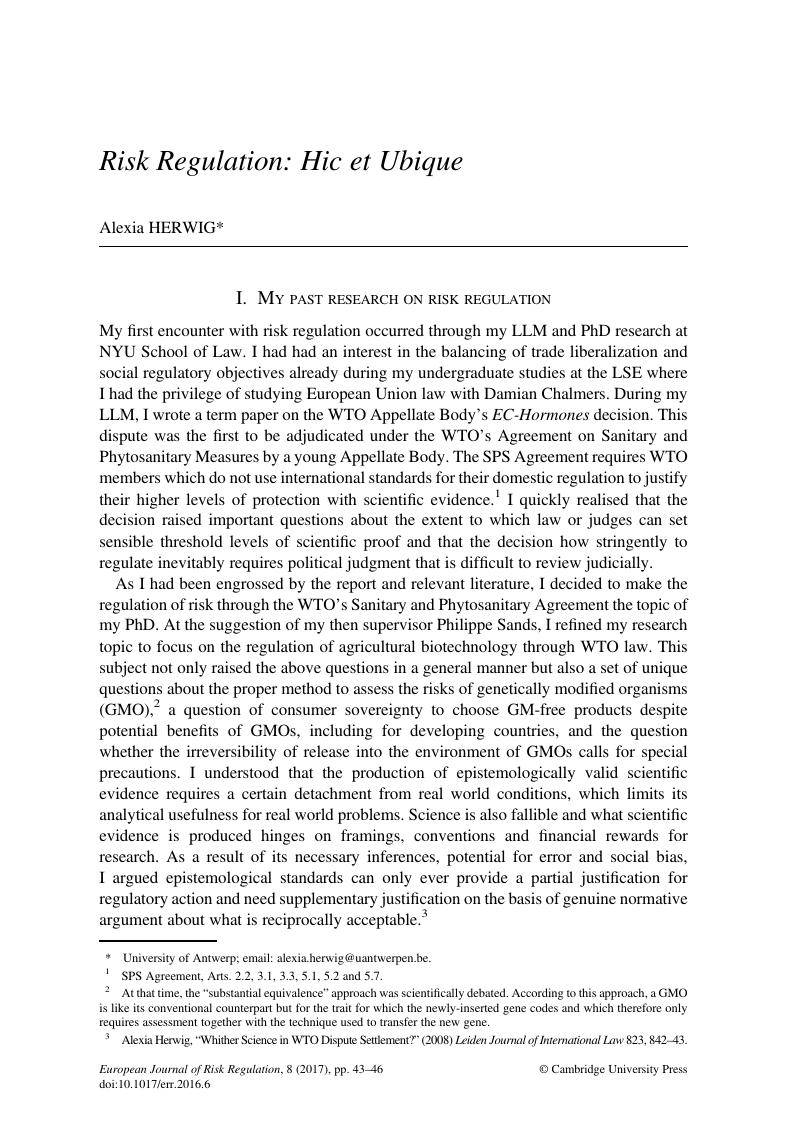No CrossRef data available.
Article contents
Risk Regulation: Hic et Ubique
Published online by Cambridge University Press: 26 April 2017
Abstract

- Type
- Contributions
- Information
- European Journal of Risk Regulation , Volume 8 , Issue 1: Cambridge Inaugural Issue: The Past, Present And Future of Risk Regulation , March 2017 , pp. 43 - 46
- Copyright
- © Cambridge University Press
Footnotes
University of Antwerp; email: alexia.herwig@uantwerpen.be.
References
1 SPS Agreement, Arts. 2.2, 3.1, 3.3, 5.1, 5.2 and 5.7.
2 At that time, the “substantial equivalence” approach was scientifically debated. According to this approach, a GMO is like its conventional counterpart but for the trait for which the newly-inserted gene codes and which therefore only requires assessment together with the technique used to transfer the new gene.
3 Alexia Herwig, “Whither Science in WTO Dispute Settlement?” (2008) Leiden Journal of International Law 823, 842–43.
4 Christian Joerges and Christine Godt, “Free Trade: The Erosion of National and the Birth of Transnational Governance” in Michael Zürn and Stephan Leibfried (eds), Transformation of the State (2005) 93, 111.
5 N Luhmann, “Risiko und Gefahr” in N Luhmann, Soziologische Aufklärung 5 Konstruktivistische Perspektiven (2005) 138–39, 148, 155.
6 Alexia Herwig, “Health Risks, Experts and Decision-Making within the SPS Agreement and the Codex Alimentarius” in Monika Ambrus et al., The Role of “Experts” in International and European Decision-Making Processes (2014) 194.
7 Jürgen Habermas, Between Facts and Norms. Contributions to a Discourse Theory of Law and Democracy (MIT Press 1996) 104.
8 The insight that the law must take seriously the capacity to reason of legal subjects because it is supposed to protect the autonomy of equal moral agents was articulated by George Pavlakos, “Constitutional Rights, Balancing and the Structure of Autonomy” (2011) 24 Canadian Journal of Law and Jurisprudence 129, 148–51.
9 Paul Slovic The Perception of Risk (2000), and “Perception of Risk” (1987) 236 Science 280.
10 Aaron James, “Contractualism’s (Not So) Slippery Slope” (2012) 18 Legal Theory 262, 280.
11 Iris M Young, “Responsibility and Global Labour Justice” (2004) The Journal of Political Philosophy 365, 368, 375.




